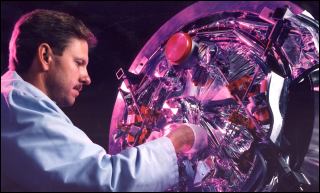Jefferson Lab Site Tour
Why use niobium to make the cavities?
Each one of Jefferson Lab's 338 acceleration cavities cost about $30,000. A good portion of this expense comes from the use of niobium, a relatively rare and expensive metal. Why were the cavities made from niobium when they could have been made from a less expensive metal, such as copper?
Most metals are good conductors of electricity, but they aren't perfect. A property of metals, known as resistance, opposes the flow of electrical currents and converts electrical energy to heat. Unless the metal is part of something that is suppose to get hot (an oven, toaster, space heater or similar device), the heat is a waste product and adds to the expense of operating the device.
Jefferson Lab's cavities work by moving charges back and forth over its surface. This movement of charges is an electrical current. If Jefferson Lab's cavities were made from copper, the cavities would heat, expand and eventually melt. This would not be good for the accelerator.
There are two ways to avoid this problem. The first is to run the accelerator for very short periods of time and allow much longer periods in between for the cavities to cool. Unfortunately, this greatly increases the amount of time it takes to conduct an experiment. The second way is to eliminate the electrical resistance within the cavities. This is why Jefferson Lab's cavities are made from niobium.
Niobium, at room temperature, has electrical resistance and behaves just like copper. If, however, niobium is cooled to very low temperatures, it loses all electrical resistance and becomes what scientists call a superconductor. Since superconductors have no electrical resistance, electrical currents flowing through them do not lose any energy and do not produce any waste heat. If no heat is created, the cavities can not heat up and the accelerator does not need to shut down to allow them to cool. The use of superconductive niobium cavities allows the accelerator to provide a continuous beam of electrons to the experiments.
In order for niobium to become superconductive, it must be cooled far below the freezing point of water. The cavities are immersed in a bath of liquid helium at a temperature of -271°C (-456°F). This is only 2°C above absolute zero, the coldest possible temperature. The cavities and liquid helium are shielded from the heat of the outside world inside large, very well insulated containers called cryomodules.
Citation and linking information
For questions about this page, please contact Education Web Administrator.

